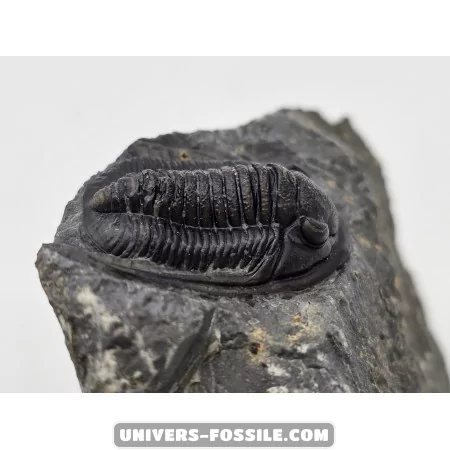Cornuproetus cornutus - Fossilized Trilobite for Collectors and Enthusiasts

Cornuproetus cornutus Trilobites
Trilobites are an extinct class of marine arthropods that thrived hundreds of millions of years ago. Among the many species of trilobites, Cornuproetus cornutus is one of the most fascinating.
- Cornuproetus cornutus was a medium-sized trilobite belonging to the order Proetida. It lived during the Devonian period, approximately 390 to 360 million years ago.
- Body: Like all trilobites, Cornuproetus cornutus had a body divided into three lobes: the cephalon (head), thorax (body), and pygidium (tail).
- Shape: The body of Cornuproetus cornutus was oval and slightly flattened, with an outer surface covered in a hard, segmented exoskeleton.
- Eyes: This trilobite possessed large compound eyes, which likely enabled it to detect movement and light in its environment.
- Spines: A distinctive feature of Cornuproetus cornutus was the presence of two pronounced spines extending from its cephalon, giving it a unique and recognizable appearance.
Habitat and Distribution:
Trilobites, including Cornuproetus cornutus, were marine creatures that inhabited ancient seas and oceans.
Cornuproetus cornutus - Intriguing Trilobite Fossil
Cornuproetus cornutus was an ancient marine creature that existed during the Devonian period when vast seas covered much of the Earth. Fossils of this intriguing trilobite have been discovered in various regions across the globe, including Europe, North America, and Africa.
Lifestyle of Cornuproetus cornutus
Cornuproetus cornutus is believed to have been a benthic predator, specialized in feeding on small marine organisms using its unique mouthparts. As trilobites have been extinct for a long time, modern understanding of their lifestyle is primarily derived from fossil analyses and studies of related species.
Extinction of Trilobites
Trilobites, including Cornuproetus cornutus, thrived for hundreds of millions of years before facing extinction around 252 million years ago during the Permian-Triassic event. The exact reasons behind their extinction remain a hotly debated topic among paleontologists, with environmental changes like sea level fluctuations and volcanic eruptions thought to have played a role.
Significance of Trilobite Fossils
The fossils of trilobites, such as Cornuproetus cornutus, hold immense value for paleontologists as they offer insights into past biodiversity, the evolution of arthropods, and ancient marine ecosystems. These fossilized remains provide a window into the Earth's distant past and continue to fascinate scientists and enthusiasts alike.
Cornuproetus cornutus - Fascinating Trilobite Fossil
Discover the intriguing world of Cornuproetus cornutus, a unique species of trilobite that roamed ancient seas millions of years ago. These well-preserved fossils offer a glimpse into the past, showcasing the intricate details of this now-extinct marine creature.
Belonging to the category of Trilobites, Cornuproetus cornutus is a sought-after specimen among collectors and fossil enthusiasts alike. Its distinctive features and historical significance make it a prized addition to any collection.
Their fossils are also highly prized by collectors and fossil enthusiasts.
In conclusion, Cornuproetus cornutus is a fascinating species of trilobite that bears witness to the richness and diversity of ancient marine life. Its distinctive appearance and role in the Devonian marine ecosystems make it a subject of interest for scientists and fossil enthusiasts worldwide.
